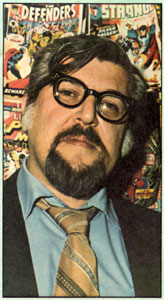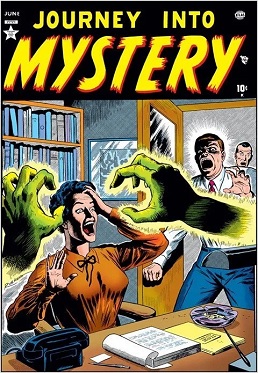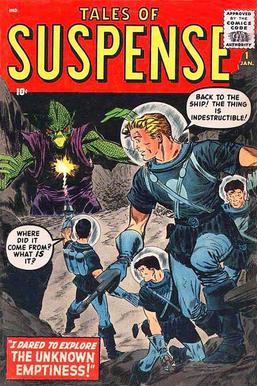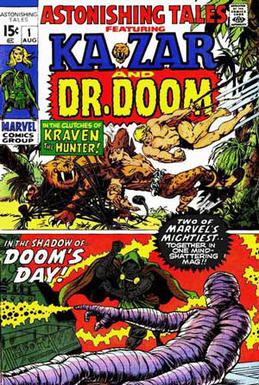
The Avengers are a team of superheroes appearing in American comic books published by Marvel Comics, created by writer-editor Stan Lee and artist/co-plotter Jack Kirby. The team made its debut in The Avengers #1. Labeled "Earth's Mightiest Heroes," the original Avengers consisted of Iron Man, Ant-Man, Hulk, Thor and the Wasp. Captain America was discovered trapped in ice in issue #4, and joined the group after they revived him.

The Avengers is the name of several comic book titles featuring the team the Avengers and published by Marvel Comics, beginning with the original The Avengers comic book series which debuted in 1963.

Dr. Henry Jonathan "Hank" Pym is a character appearing in American comic books published by Marvel Comics. Created by penciller Jack Kirby, editor-plotter Stan Lee and writer Larry Lieber, the character first appeared in Tales to Astonish #27. He returned several issues later as the original iteration of Ant-Man, a superhero with the power to shrink to the size of an ant. Later, Pym goes on to assume other superhero identities, including the also size-changing Giant-Man and Goliath; the insect-themed Yellowjacket; and briefly the Wasp. He is a founding member of the Avengers superhero team as well as the creator of the robotic villain Ultron.

John Buscema was an American comic book artist and one of the mainstays of Marvel Comics during its 1960s and 1970s ascendancy into an industry leader and its subsequent expansion to a major pop-culture conglomerate. His younger brother Sal Buscema is also a comic book artist.

Uncanny X-Men, originally published as The X-Men, is an American comic book series published by Marvel Comics since 1963, and is the longest-running series in the X-Men comics franchise. It features a team of superheroes called the X-Men, a group of mutants with superhuman abilities led and taught by Professor X.

Journey into Mystery is an American comic book series initially published by Atlas Comics, then by its successor, Marvel Comics. Initially a horror comics anthology, it changed to giant-monster and science fiction stories in the late 1950s. Beginning with issue #83, it ran the superhero feature "The Mighty Thor", created by writers Stan Lee and Larry Lieber and artist Jack Kirby, and inspired by the mythological Norse thunder god. The series, which was renamed for its superhero star with issue #126, has been revived three times: in the 1970s as a horror anthology, and in the 1990s and 2010s with characters from Marvel's Thor mythos. The title was also used in 2019 for a limited series as part of the "War of the Realms" storyline.

Tales of Suspense is the name of an American comic book anthology series, and two one-shot comics, all published by Marvel Comics. The first, which ran from 1959 to 1968, began as a science-fiction anthology that served as a showcase for such artists as Jack Kirby, Steve Ditko, and Don Heck, then featured superheroes Captain America and Iron Man during the Silver Age of Comic Books before changing its title to Captain America with issue #100. Its sister title was Tales to Astonish. Following the launch of Marvel Legacy in 2017, Tales of Suspense was once again resurrected at issue #100, featuring the Winter Soldier and Hawkeye in a story called "The Red Ledger".
Strange Tales is a Marvel Comics anthology series. The title was revived in different forms on multiple occasions. Doctor Strange and Nick Fury, Agent of S.H.I.E.L.D. made their debuts in Strange Tales. It was a showcase for the science fiction/suspense stories of artists Jack Kirby and Steve Ditko, and for the groundbreaking work of writer-artist Jim Steranko. Two previous, unrelated magazines also bore that title.

Marvel Feature was a comic book showcase series published by Marvel Comics in the 1970s. It was a tryout book, intended to test the popularity of characters and concepts being considered for their own series. The first volume led to the launch of The Defenders and Marvel Two-in-One, while volume two led to an ongoing Red Sonja series.

Marvel Fanfare was an anthology comic book series published by American company Marvel Comics. It was a showcase title featuring a variety of characters from the Marvel universe.

Marvel Super-Heroes is the name of several comic book series and specials published by Marvel Comics.
Egghead is an alias used by two supervillains appearing in American comic books published by Marvel Comics.

It! The Living Colossus is a fictional character appearing in American comic books published by Marvel Comics. Initially a statue animated by a hostile extraterrestrial, he first appeared in the science-fiction anthology series Tales of Suspense #14, in a story drawn by Jack Kirby. He was revived in Astonishing Tales #21 by writer Tony Isabella and artist Dick Ayers as the protagonist of a short-lived feature, in which he was animated by a wheelchair-using special-effects designer.
The Teen Brigade is either of two distinct fictional teams appearing in American comic books published by Marvel Comics. Both teams were recruited by Rick Jones from young amateur radio enthusiasts in order to obtain and divulge strategic information about safety hazards, usually involving the Hulk. These teams were attempting to aid the Hulk in using his super strength for good. They knew he, the Hulk, just desired to help citizens, and did not intend to harm them. The first group was founded in The Incredible Hulk #6. Today, a lot of adolescents are unaware of the Teen Brigade teams. Unless they have access to original comic books, the only Hulk character they may be aware of is in more modern shows or movies.

Astonishing Tales is an American anthology comic book series originally published by Marvel Comics from 1970 to 1976. Its sister publication was Amazing Adventures.

Marvel Collectors' Item Classics was an American comic book series published by Marvel Comics in the mid- to late-1960s that marked the first reprinting of many of the earliest Marvel stories. Primarily focused on the Fantastic Four, Iron Man, Doctor Strange, and the Hulk, it ran 22 issues before changing its name and page-count, becoming Marvel's Greatest Comics.

Stan Lee was an American comic book writer, editor, publisher, and producer. He rose through the ranks of a family-run business called Timely Comics which would later become Marvel Comics. He was the primary creative leader for two decades, leading its expansion from a small division of a publishing house to a multimedia corporation that dominated the comics and film industries.
Marvel Fireside Books were a series of full-color trade paperbacks featuring Marvel Comics stories and characters co-published by Marvel and the Simon & Schuster division Fireside Books from 1974 to 1979. The first book, 1974's Origins of Marvel Comics, was very successful, and inspired a series of annual sequels.

The Incredible Hulk is an ongoing comic book series featuring the Marvel Comics superhero the Hulk and his alter ego Dr. Bruce Banner. First published in May 1962, the series ran for six issues before it was cancelled in March 1963, and the Hulk character began appearing in Tales to Astonish. With issue #102, Tales to Astonish was renamed to The Incredible Hulk in April 1968, becoming its second volume. The series continued to run until issue #474 in March 1999 when it was replaced with the series Hulk which ran until February 2000 and was retitled to The Incredible Hulk's third volume, running until March 2007 when it became The Incredible Hercules with a new title character. The Incredible Hulk returned in September 2009 beginning at issue #600, which became The Incredible Hulks in November 2010 and focused on the Hulk and the modern incarnation of his expanded family. The series returned to The Incredible Hulk in December 2011 and ran until January 2013, when it was replaced with The Indestructible Hulk as part of Marvel's Marvel NOW! relaunch.

















